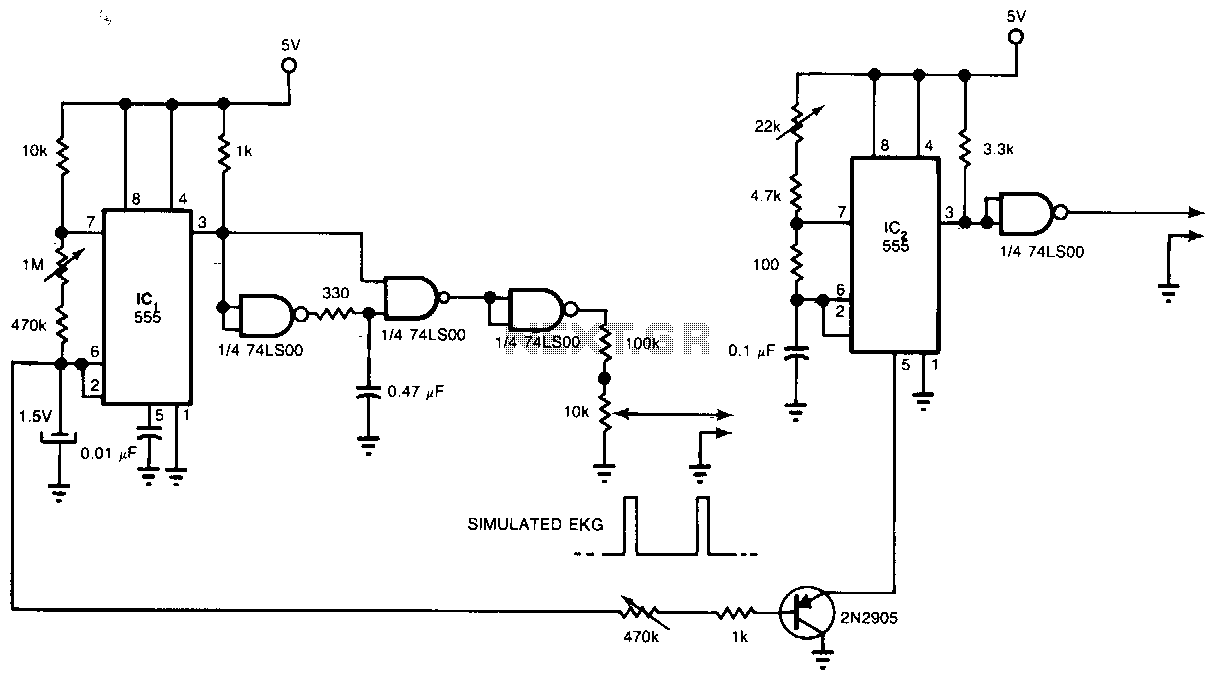
Three-chip-ekg-simulator

Two 555 timers and a quad NAND-gate integrated circuit can simulate an electrocardiograph (EKG) signal and a gamma-ray radioisotope signal for applications in nuclear medicine. This circuit synchronizes the radioisotope signal to the EKG signal. The outputs of the circuit can be utilized to test microprocessor-based software that calculates the left ventricular ejection fraction prior to clinical application. IC1, a 555 timer, generates a positive-going pulse train that simulates the EKG signal. A 10-KΩ potentiometer allows for frequency adjustment. The second 555 timer, configured as a pulse-position modulator, generates the simulated gamma-ray activity.
The circuit consists of two 555 timer integrated circuits (ICs) and a quad NAND-gate IC, which work together to produce signals that mimic the physiological and diagnostic activities of an electrocardiograph and gamma-ray emissions. The first 555 timer (IC1) is set up in astable mode to create a continuous pulse train that represents the EKG signal. The frequency of this pulse train can be fine-tuned using a 10-KΩ potentiometer, allowing for adjustments based on specific testing requirements or application needs.
The second 555 timer is configured as a pulse-position modulator (PPM). This configuration allows the timer to generate a signal that simulates the activity of gamma-ray emissions, which is essential for testing nuclear medicine applications. The timing and position of the pulses can be adjusted to match the characteristics of the desired gamma-ray signal, ensuring accurate simulation.
The quad NAND-gate IC is used to synchronize these two signals, providing a coherent output that can be utilized for testing various microprocessor-based software systems. This synchronization is crucial for applications that require precise timing between the EKG and gamma-ray signals, such as in the assessment of left ventricular ejection fraction.
Overall, this circuit serves as a valuable tool for researchers and developers in the field of nuclear medicine, enabling the testing and validation of software algorithms before they are deployed in clinical environments. The ability to simulate both EKG and gamma-ray signals in a single setup streamlines the development process and enhances the reliability of software solutions in medical diagnostics.Two 555s and a quad NAND-gate IC can simulate an electrocardiograph signal and a -y-wave radioisotope signal for applications in nuclear medicine. This circuit synchronizes the radioisotope signal to the EKG signal. You can use the circuit"s outputs to test, for example, microprocessor-based software that calculates the left ventricular ejection fraction before you use the software in clinical applications.
IC1. a 555 timer, provides a positive-going pulse train that simulates an EKG signal. A 10-KO potentiometer provides frequency adjustment. The other 555 timer, configured as a pulse-position modulator, provides the simulated -y-wave activity.
The circuit consists of two 555 timer integrated circuits (ICs) and a quad NAND-gate IC, which work together to produce signals that mimic the physiological and diagnostic activities of an electrocardiograph and gamma-ray emissions. The first 555 timer (IC1) is set up in astable mode to create a continuous pulse train that represents the EKG signal. The frequency of this pulse train can be fine-tuned using a 10-KΩ potentiometer, allowing for adjustments based on specific testing requirements or application needs.
The second 555 timer is configured as a pulse-position modulator (PPM). This configuration allows the timer to generate a signal that simulates the activity of gamma-ray emissions, which is essential for testing nuclear medicine applications. The timing and position of the pulses can be adjusted to match the characteristics of the desired gamma-ray signal, ensuring accurate simulation.
The quad NAND-gate IC is used to synchronize these two signals, providing a coherent output that can be utilized for testing various microprocessor-based software systems. This synchronization is crucial for applications that require precise timing between the EKG and gamma-ray signals, such as in the assessment of left ventricular ejection fraction.
Overall, this circuit serves as a valuable tool for researchers and developers in the field of nuclear medicine, enabling the testing and validation of software algorithms before they are deployed in clinical environments. The ability to simulate both EKG and gamma-ray signals in a single setup streamlines the development process and enhances the reliability of software solutions in medical diagnostics.Two 555s and a quad NAND-gate IC can simulate an electrocardiograph signal and a -y-wave radioisotope signal for applications in nuclear medicine. This circuit synchronizes the radioisotope signal to the EKG signal. You can use the circuit"s outputs to test, for example, microprocessor-based software that calculates the left ventricular ejection fraction before you use the software in clinical applications.
IC1. a 555 timer, provides a positive-going pulse train that simulates an EKG signal. A 10-KO potentiometer provides frequency adjustment. The other 555 timer, configured as a pulse-position modulator, provides the simulated -y-wave activity.